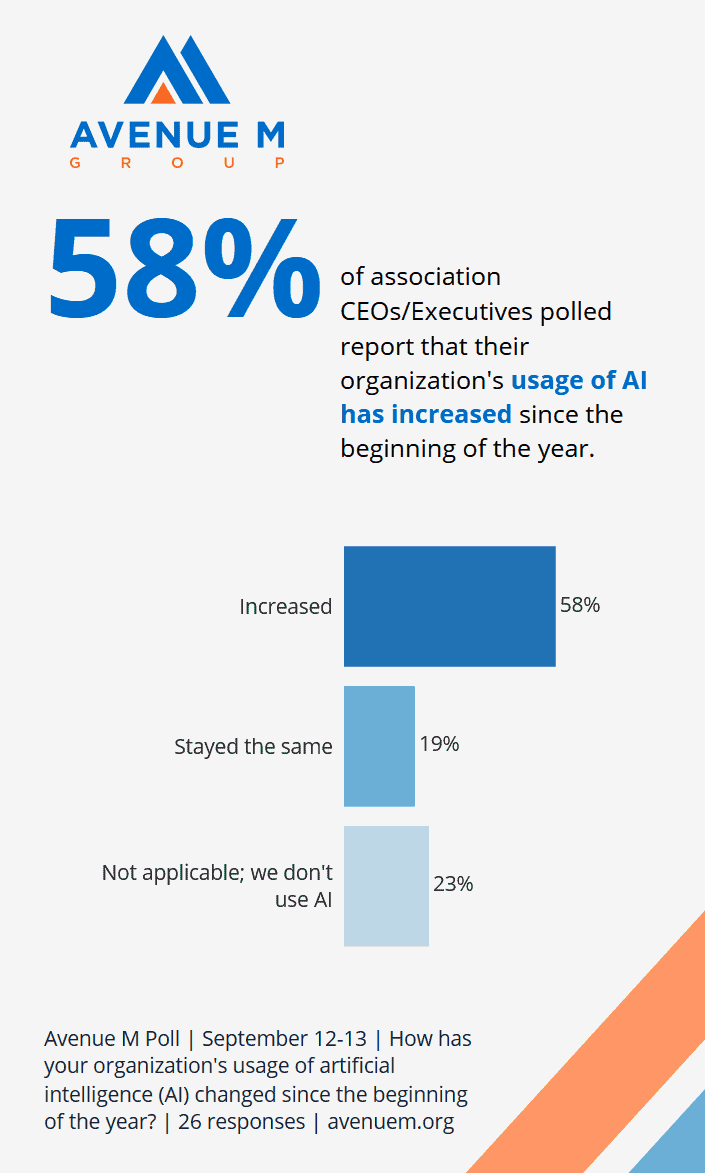A drastic shift in sentiment towards AI emerges among association executives, with more organizations leveraging artificial intelligence for enhanced productivity and member engagement.
AI (e.g., ChatGPT, Bard, Copilot) is suddenly everything, everywhere, all at once. Associations realized it can be a remarkably effective tool. AI can help increase productivity, strengthen member relationships, save money, and eliminate repetitive tasks so employees can focus on more creative, meaningful work—among many advantages.
While it didn’t happen overnight, it occurred pretty quickly. In February of this year, only 8 percent of association executives said their organizations planned to use ChatGPT to engage with members, according to an Avenue M text poll.
Fast forward seven months and things have changed—a lot. Now, 58 percent of associations say their organizations have increased their use of AI, 23 percent said they don’t use AI, and 19 percent said their AI usage has stayed the same since the beginning of the year, according to a mid-September Avenue M text poll.

When asked which areas AI usage has increased one executive panelist said, “Several staff use AI to create initial drafts of various documents. This builds on our use of AI, which was [previously] on specific elements like our e-newsletter.” Several executives said they are using AI more now for communications and marketing.
Another executive said that while they are not currently using it, they are considering it for “brainstorming and documentation structure” and journal content and education. One leader said that even though their AI use has remained the same, they are exploring new tools and strategies because “staff curiosity has increased dramatically!”
Understandable. There are lots of reasons for associations to use AI. For example, AI adds a personalized touch to how associations interact with their members by using data analysis, chatbots, and predictive tricks. These tactics mean giving members communications that are more tailored to their needs, providing quick responses to their questions, and delivering offers that match their preferences. AI also helps find potential new members and keeps existing ones on board.
AI does not come without risks, however, and must be managed effectively, with guardrails in place. Notably, a June Avenue M text poll. found that 88 percent of association executives and HR professionals said their organizations did not have an Acceptable AI Usage policy, but nearly half were developing one.
Bottom line? AI use is on the rise and its potential is being tapped into by associations, with much more likely to come.
Want to partipate in future text polls? You can sign up HERE.
For more insights on effectively harnessing AI’s potential, read Avenue M’s quick summaries of the following resources and click the links below.
The State of AI in 2023: Generative AI’s Breakout Year
McKinsey’s latest annual McKinsey Global Survey reveals AI is rapidly gaining ground, with one-quarter of C-suite executives saying they are personally using AI tools for work, and 40 percent of respondents saying their organizations will increase investment in AI overall because of advances in AI.
However, risk management efforts are still catching up, with less than half addressing the main risk: inaccuracy. Notably, organizations that are proficient in traditional AI, which McKinsey refers to as “AI high performers,” are leading the charge in AI adoption.
AI is expected to bring significant business disruption, including workforce cuts in specific areas and extensive reskilling. However, it hasn’t significantly boosted the adoption of other AI technologies. Overall, AI tool adoption has remained static since 2022, mainly limited to a few business functions.
Managing the Risks of Generative AI
AI is gaining widespread popularity, capturing the attention of corporate executives, academics, and policymakers alike. It stands ready to revolutionize the way we learn, work, and engage with various aspects of life. Particularly in the business realm, generative AI holds the promise of reshaping customer interactions and fostering growth for companies.
New research shows that 67 percent of senior IT leaders are prioritizing generative AI for their business within the next 18 months, with one-third naming it as a top priority.
To use generative AI responsibly, organizations will need a clear framework aligning AI goals with specific business functions like sales, marketing, commerce, and IT. By committing to ethical guidelines and proactive safeguards, companies can harness generative AI’s power while ensuring accuracy, safety, and trustworthiness.
More U.S. Workers Fear Technology Making Their Jobs Obsolete
A new Gallup survey found that 22 percent of workers say they worry technology will make their jobs obsolete—a fear that went up seven percentage points from when the survey was conducted in 2021.
Workers’ top job concerns are potential reductions in benefits, with 31 percent fearing benefit loss, followed by 24 percent worried about wage cuts. Among college-educated workers, this worry has surged from 8 percent to 20 percent.
Approximately one in five workers is concerned about various risks, including job displacement due to technology (22 percent), layoffs (20 percent), and reduced hours (19 percent). The least worrisome risk is job outsourcing (7 percent). Notably, only the fear of technology threatening jobs has significantly increased since 2021, while the other concerns remain below post-Great Recession levels.
Want to learn more about cutting-edge tech and strategies through the industries and organizations using them? Consider attending digitalNow 2023.
Want to be the first to be notified about articles like this? You can learn more about ASAE and Avenue M’s texting poll service HERE.
Contributors: Sheri Jacobs, FASAE, CAE & Lisa Boylan
(Image: Adobe Stock Images)